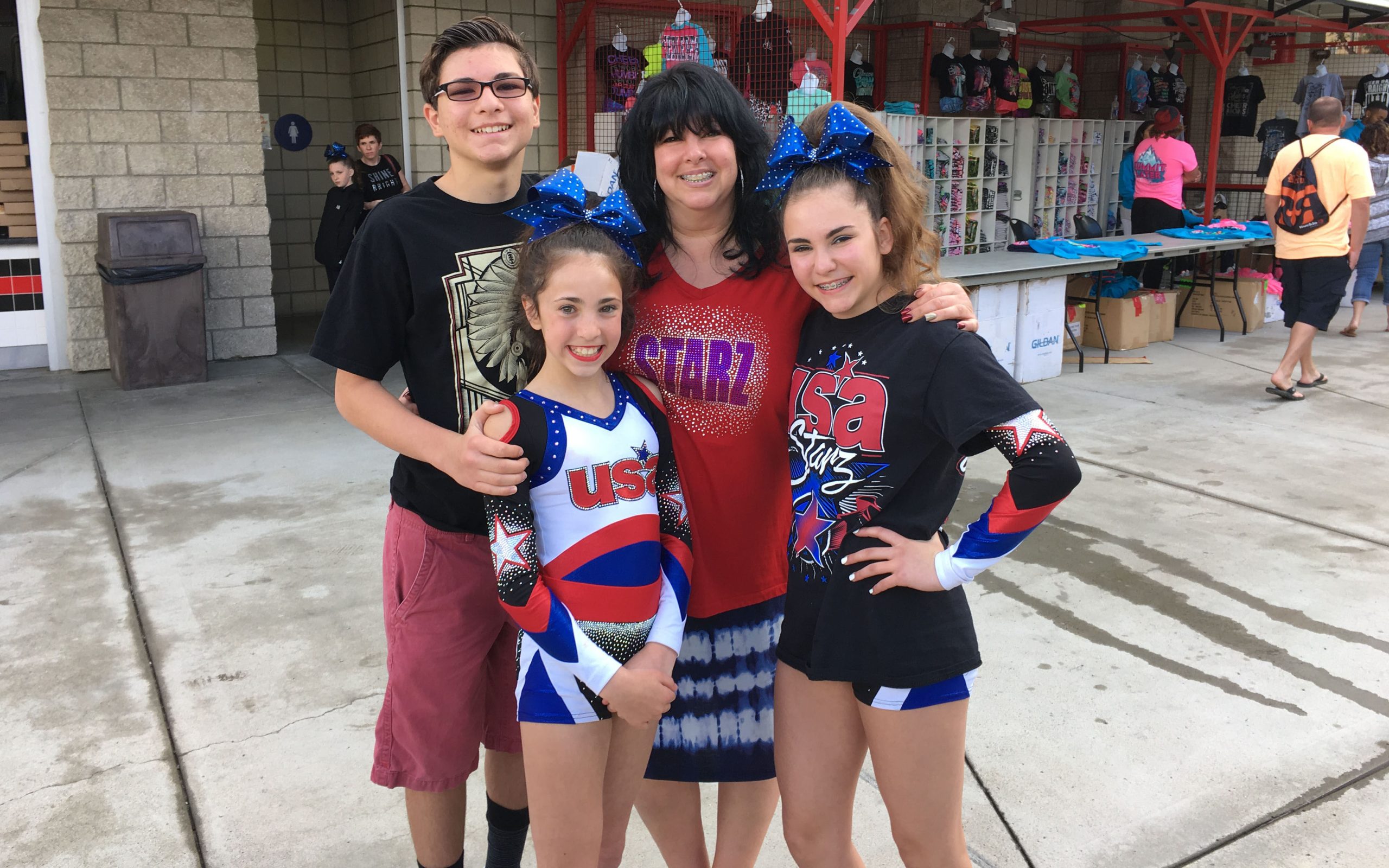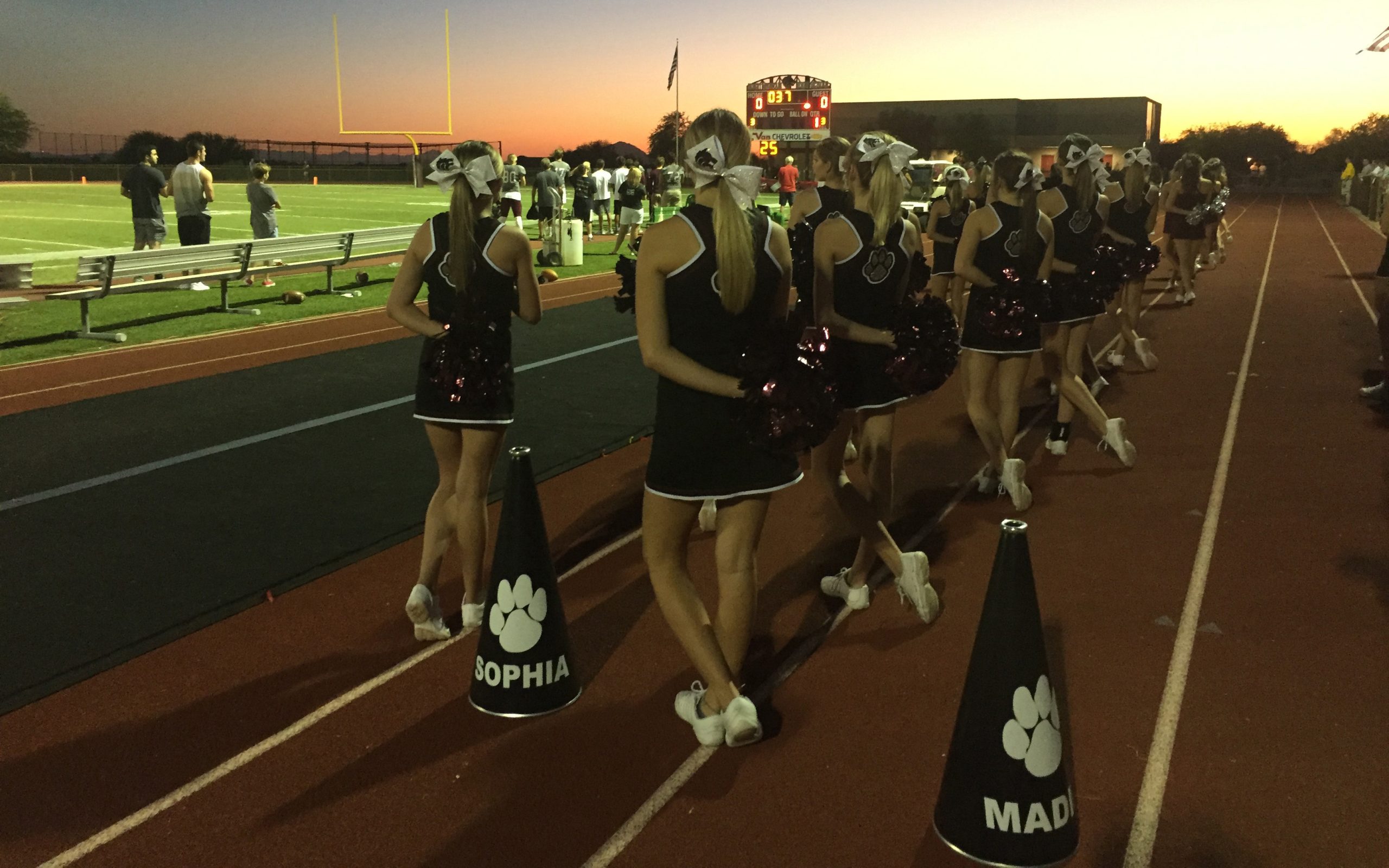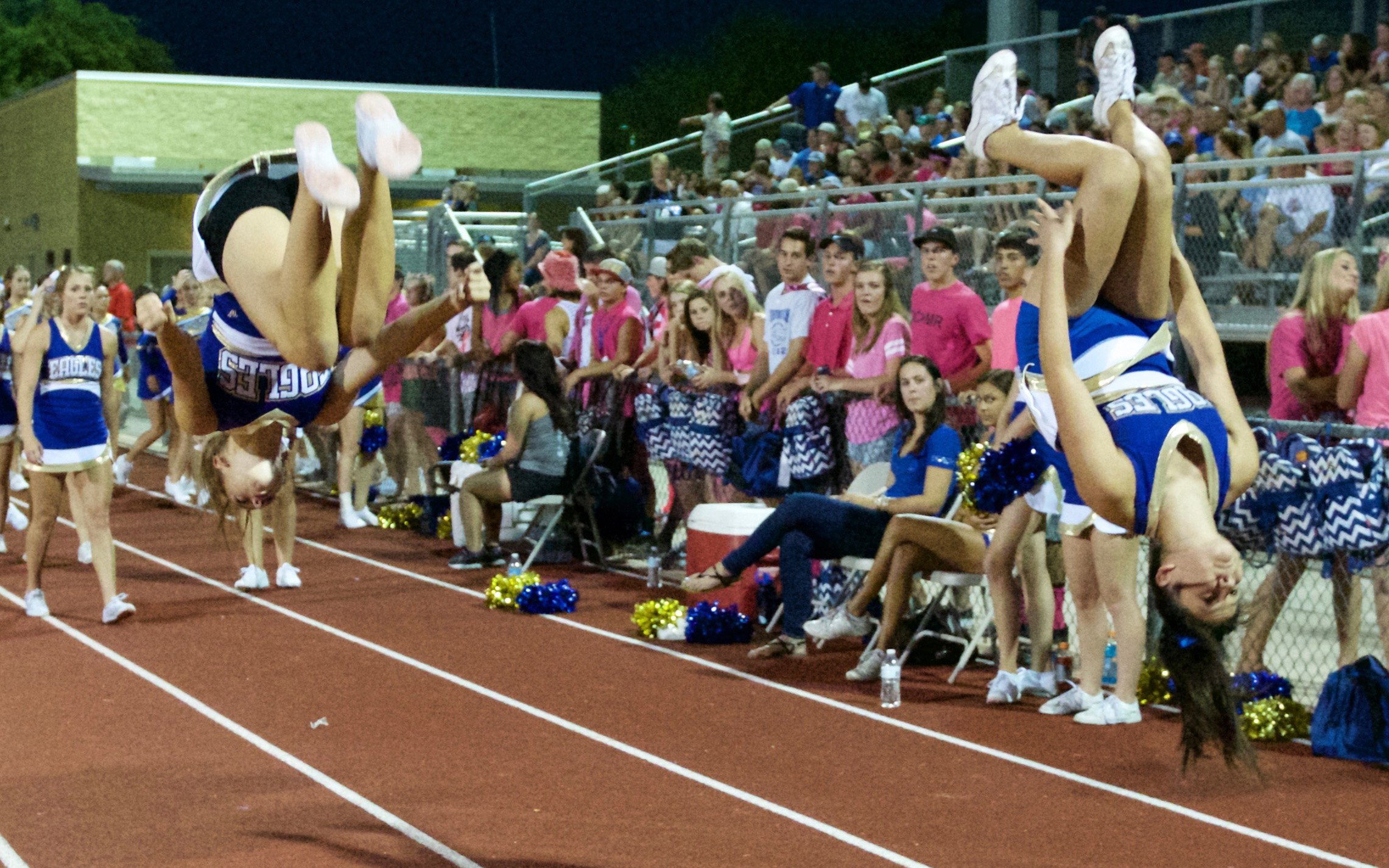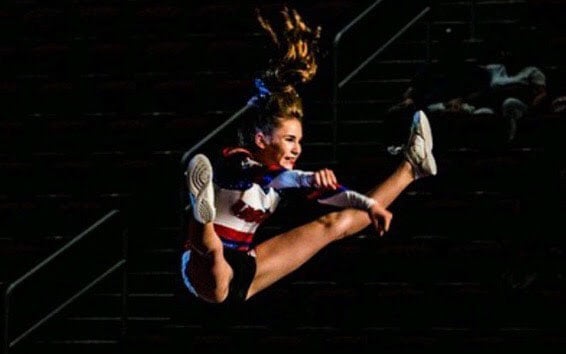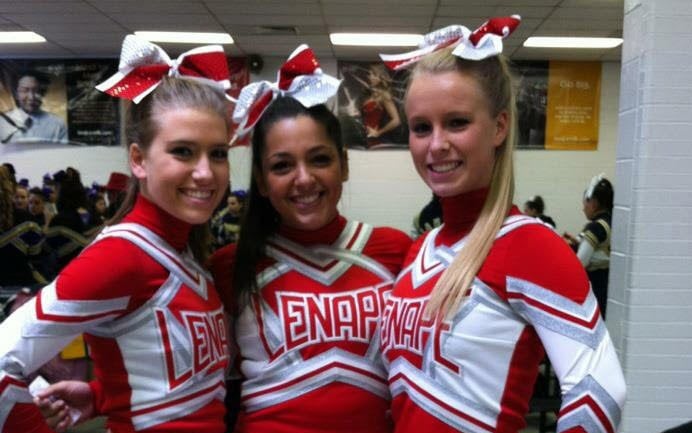After a third concussion, Lisa Caiazzo was terrified for her daughter’s future.
“She was talking funny. She didn’t make sense. She was so out of it. She just wanted to sleep,” she said of Alexa. “She walked out, she was … Oh God. Her eyes were like … It was like you were looking right through her. It was like she couldn’t even see you.”
It was then Lisa decided to pull her daughters out of cheer.
They tumble, they fly and they do it all with smiles on their faces. But behind the big bows and the sparkly pompoms of the sport, another truth emerges: Cheerleading is dangerous, too.
The sport was responsible for 65 percent of direct catastrophic injuries to female high school athletes during a 27-year period, according to a 2012 study by the American Academy of Pediatrics. This supported a 2009 report from the National Center for Catastrophic Sports Injury Research at the University of North Carolina that concluded cheerleading accounted for 65.2 percent of all catastrophic injuries in youth sports.
The risk connected to cheerleading continues to rise as the difficulty of skills performed increases.
During his 31 years of practice, Phoenix orthopedic surgeon Douglas Hartzler has treated numerous cheerleaders for injuries.
“I would agree that cheerleading on a percentage basis, meaning that the number of participants that do cheerleading versus the number of injuries that are sustained, probably has a higher frequency than most sporting activities,” Hartzler said.
Alexa Caiazzo, a former cheerleader at USA Starz in Gilbert, suffered three concussions in approximately six weeks. She began cheering when she was 9 and was hooked immediately, competing shortly after and traveling all over with her team.
“I was there four to six days a week for almost eight years. I loved it with everything,” Alexa said.
After suffering her three concussions, Alexa missed two weeks of school because of her symptoms. She had extreme light and sound sensitivity and slept almost day and night. When she returned to school, the lights in the classroom and the sounds were somewhat overwhelming for her.
The concussions caused her to have issues with schoolwork. Not only did it put her behind, but it also made it difficult to remember things like math formulas. She also struggled with writing, forgetting how to spell simple words, and would confuse letters like “b” and “d.”
The look that Lisa described on the day she picked Alexa up after the third concussion was a look that haunted her for months
“That blank stare. That not understanding,” Lisa said. “You know somebody with Alzheimer’s? That’s what I felt like she was like. She just had no clue.”
Today, although she is about 75 percent healed, Alexa still has problems with comprehension.
“I think that’s what has upset me most throughout the year,” she said. “Today, it’s still happening, where someone will tell me something and I’ll have to concentrate extra hard, or I’ll have to say, ‘Say it again’, and break it down piece by piece.”
Part of the reason so many cheerleaders sustain serious injuries is because of what is required, Hartzler said. They do gymnastics skills on hard surfaces and rely on other people for safety, which can sometimes be unreliable.
“The most common are the shoulder, elbow, ankle, and foot, and occasionally the knee, as well,” he said. “Most of it involves tumbling. Tumbling involves the upper extremities … the shoulder, the elbow, and also the foot and ankle takes a pounding.”
It is not just the bones that are subject to injury. The soft tissue surrounding the bone, along with the ligaments and tendons, are also put at risk. Also, the rate of concussions in cheer is a problem, although physicians like Hartzler do not deal with them in their practice.
Still, he is no stranger to the dangers that come with cheerleading.
“I can speak from my own experience that my daughter sustained a fracture dislocation of her ankle in doing a tumbling maneuver,” Hartzler said.
Guidelines have been in place for high school cheer in order to try to combat injuries, yet none of these safety measures can completely eliminate the risk.
One common measure nationally calls for cheerleaders doing stunts to have a padded mat below them if they are on a hard surface besides grass. In Arizona, coaches also have to pass certification courses.
Eric Contreras, the owner of Desert Storm Cheer in Scottsdale and head coach of Desert Mountain High School’s varsity cheer team, said safety measures have been put in place by the Arizona Interscholastic Association.
“You can’t throw basket tosses without a foam mat, things like that, on the wood floor,” Contreras said. “Something that’s gonna, you know, break a fall if someone is to slip through someone’s hands. We want them to be safe, and if they hit a mat it prevents injuries from being real serious.”
Contreras also is part of a small focus group of coaches that helps the AIA make important decisions regarding the activity. Despite their effort, catastrophic injuries still occur.
Jordin Wilson, a former gymnast and cheerleader at Sandra Day O’Connor High School was a base, meaning that she was part of the foundation that held other cheerleaders in the air. While practicing a stunt before a basketball game, she was struck in the face by a flyer. Although she was unaware of it at the time, she had suffered a broken nose. Her mother, Denise, said they didn’t think it was that serious.
“It was bleeding and the trainer looked at it,” she said. “They basically stopped the bleeding and she was still tumbling at the game that night. We didn’t find out until a couple months later. She was having breathing problems.”
Jordin said she “mainly just felt like I had a bad headache that wouldn’t go away. My nose still throbbed and hurt so badly to touch, but for me, it was not a debilitating injury.”
Her nose had shifted, and Jordin ultimately needed surgery to fix the problem.
“I was afraid this sort of thing would happen during basing,” Jordin said. Denise stated that other cheerleaders on Jordin’s team also suffered injuries, most commonly concussions. Among smaller injuries were sore wrists from tumbling and twisted ankles.
“I saw many serious injuries during my time,” Jordin said. “One of my best friends, and my flyer at the time, suffered a very serious concussion during practice.”
Both Denise and Jordin feel that many injuries stem from a lack of experience on the coaching side, at least for a majority of high school cheer teams. It is fairly simple to become a cheer coach, and no prior experience is needed. The AIA only requires a coach to attend a course to be AACCA safety certified, on top of taking a yearly course on a National Federation of State High School Associations spirit rules course. After the coaches have attended in person once, they are permitted to take it online for years following. Coaches must also complete a one-time course on NFHS concussions in sports, and be CPR certified.
“I feel like the schools don’t take cheerleading seriously,” Denise said. “They don’t hire qualified coaches. They say it’s too hard and that no one wants to coach the team.”
Knowing what she knows now, Denise would not let Jordin cheer if she had to do it over again. “I would point her in another direction,” Denise said.
The issue of injuries among cheerleaders doesn’t discriminate between high school or club. Both are subject to a variety of different injuries. Although the Wilsons feel a majority of injuries stemmed from the lack of coaching knowledge, the Caiazzo’s do not.
“They have amazing coaches,” Lisa said when speaking about USA Starz. “It has nothing to do with the gym or anything. That gym, I went to because they’re very on top of everything. I like that feeling, it’s a very safe feeling there. If it wasn’t I would have never let my girls do it.”
When Alexa first began cheering she was a flyer. Following a growth spurt, she became a base. As her stunt group was in the process of learning a new skill, Alexa was kicked in the left temple. She didn’t know that this would be the first of three concussions that would eventually lead to her retirement from cheer.
Her symptoms were not what she expected for a concussion. She had no headaches and she didn’t feel like she was going to faint.
“I didn’t know I had a concussion and I kind of kept quiet about everything that I was feeling,” Alexa said. “My legs were in so much pain, and my arms were in so much pain, that it actually made it hard to practice.”
When Lisa took Alexa to the doctor, they found out that what she was experiencing was concussion symptoms. The doctors told Alexa to rest for two weeks before returning to cheer.
“It was a little nerve-racking, but they were like, ‘She’ll be fine’, and after two weeks she was cleared to go back,” Lisa said.
However, on the day she returned to cheer, she was hit in the head again. This time, the point of impact was directly on top of her skull.
“I guess my first (concussion) wasn’t totally healed,” Alexa said. “My head was just under the wrong spot at the wrong time and her foot kind of just stepped on me.”
This mishap was concussion No. 2 for Alexa. Again, doctors told her to sit out two more weeks before returning to cheer.
Lisa was hesitant to let Alexa return following the second concussion, but the doctors at the hospital told her not to worry.
“They were like, ‘No, she’s good,'” Lisa said. Since her symptoms weren’t awful, the doctors were not concerned. “That didn’t do much, they said, because of where she got hit in the head on the top. So we were like, ‘OK’, and the hospital said she was totally fine.”
Upon return, Alexa was kicked in the temple again. She could immediately feel a change, which was a cause for concern. “I just knew. It was the same thing, the same feeling that I got when I got kicked the first two times.” This time, she decided to tell her coach, sit out for the rest of practice and let her mom know as soon as she arrived to pick her up.
“When she got the third concussion, that’s when it was crazy,” Lisa said. “That one kind of joggled her brain, and that’s where it was really impacted.” The gym called Lisa to let her know of Alexa’s injury. They told her after she got kicked, she was talking funny and didn’t look good.
When Lisa arrived to pick Alexa up, she took her straight to the hospital. After her third concussion was when Alexa’s symptoms became extreme.
“This time I asked for a CT scan, because I had asked before and they were like ‘No, she’s fine, the CT scan just shows if there’s bleeding.’ But because her symptoms were so crazy that third time, I was like, for sure there’s got to be something else,” Lisa said.
The CT scan did not show bleeding, but the symptoms prompted Lisa to do research on finding a neurologist. Her research led her to Javier Cardeñas of Barrows Institute When Lisa called to make an appointment, they initially told her there was a huge wait. However, after hearing of Alexa’s symptoms, they got her in right away.
Now she is adjusting to living with the aftermath.
“I think that’s what has upset me most throughout the year,” she said. “Today, it’s still happening, where someone will tell me something and I’ll have to concentrate extra hard, or I’ll have to say, ‘Say it again’, and break it down piece by piece.”
Alexa had to return to the doctor frequently to monitor her improvements. Both Lisa and Alexa feel strongly that Cardeñas is responsible for her improvements.
Following Alexa’s injuries, Lisa pulled her younger daughter Bri out of cheer as well. Bri’s only injury sustained in cheer was a hairline fracture.
Lisa said looking back on it, she would still let her daughters cheer if she had to do it over again. The decision stems from the passion Alexa and Bri have for it. If Alexa’s injury was to a different part of her body, like a broken arm, she wouldn’t have pulled both of her girls from the sport.
“With the brain, it’s a totally different way of thinking about it,” Lisa said. “The brain is the brain. A break, you can fix. It can heal. You can have surgery.” She continued, “That’s not catastrophic. That’s not toying with your mind, or your memory, or your speech, comprehension, or how you live day to day.”
Catastrophic injuries in the sport are not limited to Arizona. Janelle Nodar, a former cheerleader at Lenape High School in Medford, New Jersey, broke her neck at practice.
It was the day before her high school team was traveling to Myrtle Beach, South Carolina, for nationals in the spring of 2009. Practice on the day before nationals was extended so they could go over both tumbling and routines.
“It was very traumatic,” Nodar said. “It wasn’t until the end of the practice where I just threw my pass. I guess I just over-rotated a little too much, and I just was in the air in a ball and I just kind of fell down on my neck.”
Initially, she thought she was fine.
“I just remember rolling out of the ball and laying on the mat thinking, ‘Oh my God, what just happened to me.’ ” The coaches and tumbling instructors immediately attended to Nodar. She said she thought she just had the wind knocked out of her.
Nodar moved on to the two-hour cheer routine practice as if nothing had happened. Following the practice, she went home and tried to finish packing until her mom learned of her accident.
“My sister told my mom that I fell, so she freaked out and said I had to go to the hospital. I was totally against it at first, but obviously now I’m thankful that I went,” Nodar said.
Upon arriving at the hospital, they learned of her injuries and transported her by ambulance to a nearby hospital for further evaluation.
“My X-rays showed that I had broken three vertebrae in my neck, and I was actually one vertebrae away from being paralyzed from the waist down,” she said. “So, I was extremely lucky. I was put in a neck brace. It was front and back and it went down to my waist.”
She had to wear the brace for three months. “I was helpless almost. I couldn’t really do much for myself. I really depended on my family at that point to help me do basic things.”
Following her injury, she still decided to cheer.
“It sounds kind of dumb, but cheer was such a big part of my life back then,” Nodar said. “I was just super excited to be on my cheer team and be around that and keep that competitive cheer going.”
She admitted that after the injury, it was a struggle to get back into it again, but cheer was the only thing she knew. The fear of getting injured again limited Nodar’s growth in the sport.
“I kind of got stuck after that,” she said. “I was working on advancing my tumbling passes, but after that happened I kind of just was like, this is it. I can’t really do much more than this because I was so scared of actually having it happen again, or there being complications. People don’t really realize how dangerous it really is of a sport.”
Nodar’s family was initially hesitant when she decided to return to the sport, but they eventually warmed up to the idea. If she could go back in time to when she initially tried out for Lenape’s competitive high school cheer team, she would do it all again.
“It definitely taught me a lot, the accident, so there’s a plus side to it for sure,” she said.
Orthopedic surgeon Hartzler understands that logic. His daughter cheered at Wheaton College in Illinois and sustained an injury while landing a back handspring. She, like many others, returned to the beloved sport after an injury that kept her sidelined.
To this day, Hartzler says his daughter still has issues that she has to deal with because of that injury.
However, despite the struggles he watched her endure, he would still let her cheer all over again.
